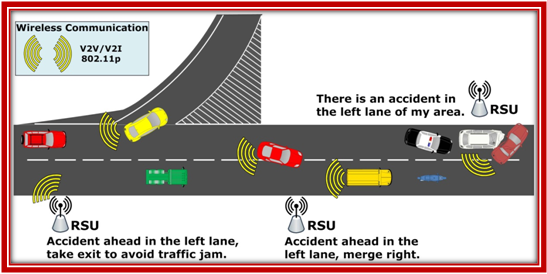Challenges on VANET:
- Admission control.
- Service differentiation.
- Geographical routing.
- Power assignment.
- Clustering.
- Efficient broadcasting.
- Opportunistic routing.
- Trajectory forwarding.
Networking properties of NS3 VANET Simulation:
- Content of messages can change the network topology.
- Potentially large-scale network.
- Variable network density.
- Rapid changes in the VANETs topology is difficult to manage.
- Rapid changes in link’s connectivity cause many paths to disconnect before they can be utilized.
- No significant power constraints.
- It’s subject to frequent fragmentation, even at a high rate of network deployment.

Ns3 Video Tutorial
Ns3 Video Tutorial – Latest NS3 Projects Output
Ns3 Tutorial
Ns3 Tutorial – Guide to Various Network Projects
Journal Support
Paper Publication for NS3 Simulation Projects
Contact Form
Contact Us- Customized Ns3 Simulator ProjectsSample code for NS3 VANET Simulation:
This is the sample code of vanet routing protocol.
void
RoutingHelper::SetupRoutingProtocol (NodeContainer & c)
{
AodvHelper aodv;
OlsrHelper olsr;
DsdvHelper dsdv;
DsrHelper dsr;
DsrMainHelper dsrMain;
Ipv4ListRoutingHelper list;
InternetStackHelper internet;
Time rtt = Time (5.0);
AsciiTraceHelper ascii;
Ptr rtw = ascii.CreateFileStream (“routing_table”);
switch (m_protocol)
{
case 0:
m_protocolName = “NONE”;
break;
case 1:
if (m_routingTables != 0)
{
olsr.PrintRoutingTableAllAt (rtt, rtw);
}
list.Add (olsr, 100);
m_protocolName = “OLSR”;
break;
case 2:
if (m_routingTables != 0)
{
aodv.PrintRoutingTableAllAt (rtt, rtw);
}
list.Add (aodv, 100);
m_protocolName = “AODV”;
break;
case 3:
if (m_routingTables != 0)
{
dsdv.PrintRoutingTableAllAt (rtt, rtw);
}
list.Add (dsdv, 100);
m_protocolName = “DSDV”;
break;
case 4:
m_protocolName = “DSR”;
break;
default:
NS_FATAL_ERROR (“No such protocol:” << m_protocol);
break;
}
if (m_protocol < 4)
{
internet.SetRoutingHelper (list);
internet.Install (c);
}
else if (m_protocol == 4)
{
internet.Install (c);
dsrMain.Install (dsr, c);
}
if (m_log != 0)
{
NS_LOG_UNCOND (“Routing Setup for ” << m_protocolName);
}
}

